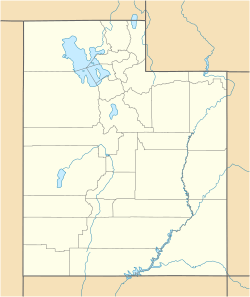Knolls, Utah facts for kids
Quick facts for kids
Knolls
|
|
|---|---|
| Country | United States |
| State | Utah |
| County | Tooele |
| Elevation | 4,229 ft (1,289 m) |
| Time zone | UTC-7 (Mountain (MST)) |
| • Summer (DST) | UTC-6 (MDT) |
| Area code(s) | 435 |
| GNIS feature ID | 1437607 |
Knolls is a small, quiet place in Tooele County, Utah, in the United States. It's called an "unincorporated community," which means it's a small settlement that doesn't have its own local government like a city or town does. Instead, it's managed by the county.
Contents
Exploring Knolls, Utah
Knolls is located in the Great Salt Lake Desert in the western part of Utah. It's quite close to the Utah Test and Training Range, a large area used for military training. You can easily get to Knolls from Interstate 80 (I‑80) by taking Exit 41.
Knolls' Past and Present
Before I-80 was built, Knolls was on U.S. Route 40. It was also the starting point of the Wendover Cut-off, an old road that crossed the desert.
Years ago, in the 1970s and early 1980s, one family owned and ran the entire community. They had a towing service, a small convenience store, a gas station, and even a tiny motel. There was no running water, so water had to be brought in by truck. Today, there are hardly any buildings left to see.
Desert Landscape and Recreation
Knolls is in a very empty desert area. It's about 40 miles (64 km) east of the famous Bonneville Salt Flats. It's also about 80 miles (129 km) west of Salt Lake City. The land around Knolls has interesting features like mud flats, shiny salt flats, and gypsum sand dunes.
Much of the land nearby is managed by the Bureau of Land Management. It's a popular spot for off-highway vehicle (OHV) riding. This area is known as the Knolls Recreation Area.
Historical Significance: GAPA Launch Site
Knolls is home to a special historical site called the GAPA Launch Site. This place is listed on the National Register of Historic Places. It has a concrete bunker and a missile launch pad.
This is where the very first "Ground to Air Pilotless Aircraft" (GAPA) missile was successfully tested in 1946. A special sign from the Utah State History division marks this important spot.
Why Knolls is Called Knolls
The community gets its name from the many small hills, or "knolls," found in the area.
Climate in the Great Salt Lake Desert
The Great Salt Lake Desert where Knolls is located has a desert climate. This means it has hot summers and cold winters. It's a great example of a "cold desert climate," which is not very common outside of North America.
The desert is about 4,250 feet (1,295 meters) above sea level. This high elevation makes the temperatures cooler than in deserts at lower elevations, like the Mojave Desert. Because it's so high and dry, temperatures drop quickly after the sun sets. Summer nights are usually cool and pleasant.
In winter, daytime temperatures are often above freezing. However, winter nights can be extremely cold, sometimes dropping close to zero degrees Fahrenheit.
| Climate data for Knolls, Great Salt Lake Desert, Utah. (Elevation 4,250ft) | |||||||||||||
|---|---|---|---|---|---|---|---|---|---|---|---|---|---|
| Month | Jan | Feb | Mar | Apr | May | Jun | Jul | Aug | Sep | Oct | Nov | Dec | Year |
| Record high °F (°C) | 63 (17) |
63 (17) |
79 (26) |
87 (31) |
98 (37) |
104 (40) |
106 (41) |
103 (39) |
99 (37) |
89 (32) |
71 (22) |
66 (19) |
106 (41) |
| Mean daily maximum °F (°C) | 36.5 (2.5) |
41.4 (5.2) |
54.4 (12.4) |
62.3 (16.8) |
72.3 (22.4) |
83.5 (28.6) |
92.8 (33.8) |
90.9 (32.7) |
80.0 (26.7) |
64.3 (17.9) |
46.5 (8.1) |
36.5 (2.5) |
63.4 (17.4) |
| Mean daily minimum °F (°C) | 16.9 (−8.4) |
19.3 (−7.1) |
29.1 (−1.6) |
36.6 (2.6) |
44.9 (7.2) |
54.7 (12.6) |
62.1 (16.7) |
59.5 (15.3) |
48.0 (8.9) |
34.4 (1.3) |
23.3 (−4.8) |
14.5 (−9.7) |
37.0 (2.8) |
| Record low °F (°C) | −16 (−27) |
−17 (−27) |
−1 (−18) |
14 (−10) |
24 (−4) |
35 (2) |
43 (6) |
39 (4) |
25 (−4) |
8 (−13) |
−3 (−19) |
−25 (−32) |
−25 (−32) |
| Average precipitation inches (mm) | 0.61 (15) |
0.46 (12) |
0.91 (23) |
1.01 (26) |
1.23 (31) |
0.68 (17) |
0.36 (9.1) |
0.31 (7.9) |
0.56 (14) |
0.77 (20) |
0.61 (15) |
0.38 (9.7) |
7.88 (200) |
| Average snowfall inches (cm) | 0.3 (0.76) |
0.1 (0.25) |
0 (0) |
0 (0) |
0 (0) |
0 (0) |
0 (0) |
0 (0) |
0 (0) |
0 (0) |
0 (0) |
0.1 (0.25) |
0.5 (1.3) |
| Source: The Western Regional Climate Center | |||||||||||||



